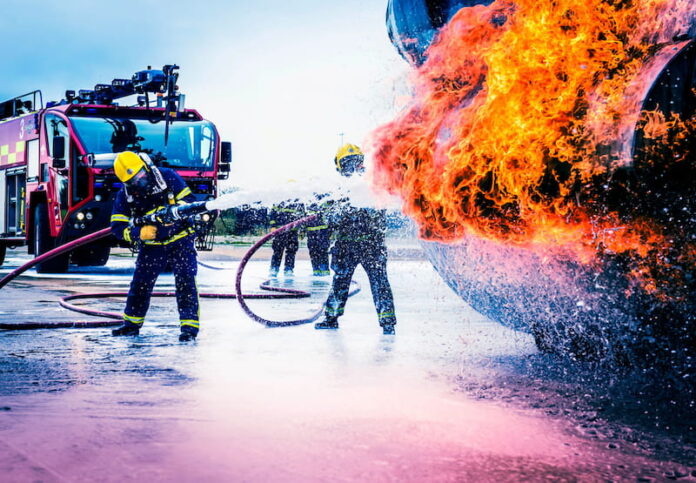Aqueous Film-Forming Foam, commonly known as AFFF, is a firefighting foam used for decades to suppress flammable liquid fires. AFFF is particularly effective for controlling fires involving fuels like gasoline and oil. The foam creates a blanket that cuts off the fire’s oxygen supply, preventing it from spreading. While AFFF is highly effective in firefighting, concerns have grown around its chemical makeup. AFFF contains per- and polyfluoroalkyl substances (PFAS), which are persistent chemicals known to accumulate in the environment and human body. Research has shown certain chemicals can be harmful. They may even cause cancer. For firefighters, who often use AFFF, understanding these risks is crucial.
What Is AFFF Made Of?
AFFF is composed of water, foam, and a combination of surfactants, which help form a film over the burning liquid. The critical ingredients in AFFF are PFAS, a group of synthetic chemicals known for their ability to resist heat, water, and oil. These chemicals do not break down easily and have earned the nickname “forever chemicals” because they remain in the environment for a long time. PFAS are used to enhance the foam’s effectiveness in fighting fuel fires. However, the same properties that make PFAS useful also make them hazardous. These chemicals can spread into the soil, water, and air, becoming common pollutants.
The Health Risks Linked to PFAS in AFFF
According to the environmental toxic exposure lawyers at the Law Firm of Douglas & London, research has increasingly linked PFAS exposure to several severe health conditions, such as kidney, testicular, and prostate cancer. It can have a severe adverse affect on your liver and thyroid, and thus weakening your immune system. Always take care of your health. For firefighters, exposure to these chemicals is of particular concern. Firefighters can come into direct contact with AFFF during training or while battling fires. They may also inhale or ingest PFAS through contaminated water or air. These chemicals can slowly accumulate in your body. They can potentially also cause serious health issues. Being aware of this risk is crucial.
Why Are Firefighters at a Higher Risk?
Firefighters face a higher risk of PFAS exposure than the general population due to their repeated and prolonged use of AFFF. They are often exposed to AFFF during firefighting operations and training exercises. Even after a fire is out, the chemicals in the foam can remain on gear, clothing, and equipment. This lingering presence can lead to further exposure long after the immediate threat has passed. Firefighters also risk ingesting PFAS by drinking contaminated water or inhaling the chemicals when they vaporize. Being around PFAS a lot can make it build up in your body. This might lead to major health issues, including cancer.
Efforts to Reduce PFAS Exposure Among Firefighters
Awareness of the risks associated with PFAS exposure has led to various efforts to reduce these risks for firefighters. Many fire departments are now opting for PFAS-free foams that offer a safer alternative to traditional AFFF. These foams are safe. They lack harmful chemicals that cause cancer and other health issues. Additionally, fire departments are improving training protocols to limit unnecessary exposure. Some organizations have also implemented guidelines for better cleaning and decontaminating equipment after exposure to AFFF. Legal actions are also being taken against manufacturers of AFFF to seek compensation for the health risks firefighters face. These steps make work safer for people on the front lines. It’s all about keeping them safe.
Legal and Regulatory Actions Surrounding AFFF
With more evidence linking AFFF to cancer, regulatory agencies and legal bodies are paying closer attention. Lawsuits against AFFF manufacturers claim they didn’t do enough to warn people about the dangers of PFAS. The EPA and other regulators are now pushing for stricter controls on PFAS use. Some states in the U.S. have banned or limited the use of PFAS-containing foams altogether. These lawsuits and regulations are crucial to tackling the risks of AFFF and ensuring manufacturers are held responsible for the harm their products cause. They also serve as a catalyst for developing safer alternatives for firefighting professionals.
AFFF has long been a go-to in firefighting because it effectively puts out flammable liquid fires. But with PFAS in the mix, it’s becoming clear that these chemicals pose serious health risks, especially for firefighters who are exposed regularly. The connection between PFAS and cancer has sparked genuine concern, driving efforts to find safer alternatives and reduce exposure. As legal and regulatory efforts increase, protecting firefighters from these dangers is more crucial than ever. Understanding the risks and taking action will help keep them safe and healthy for years.
Did you find this helpful? Check out our other helpful articles on our website.
Read Also
- Exploring the Benefits of Infusion Therapy in OKC: The Ultimate GuideUnderstanding Infusion Therapy: A Deep Dive into Its Purpose and Process What exactly is Infusion Therapy? Infusion therapy is an advanced medical treatment that delivers medication and nutrients directly into the bloodstream through a vein, typically via an IV (intravenous) line. This method is particularly beneficial for patients who require a concentrated dose of medication,… Read more: Exploring the Benefits of Infusion Therapy in OKC: The Ultimate Guide
- Ketamine-Assisted Therapies: Impacts on Employee WellbeingWorkplace stress is common today. Many employees feel tired, anxious, or burned out. Regular therapy can help, but some people need more support. Ketamine-assisted therapy is showing good results for mental health. A ketamine-assisted therapist guides each session safely. This therapy can improve mood, focus, and energy. Learning more about it can help teams stay… Read more: Ketamine-Assisted Therapies: Impacts on Employee Wellbeing
- The Future of Men’s Health: Why Telehealth Is Here to StayTelehealth isn’t just a pandemic trend that faded into the background. For Australian men, it has become one of the most practical, time-saving, and stress-free ways to manage everyday health — and it’s shaping the future of how we access care. Platforms like DOCTO, an Australian online doctor and specialist telehealth service, are leading the… Read more: The Future of Men’s Health: Why Telehealth Is Here to Stay
- How to Build a Simple, Clean Skincare Routine ?You don’t need a complicated skincare routine. It doesn’t have to be something that requires twenty different products and confusing steps. Your routine works well with just a few high-quality clean ingredients. The beauty industry keeps pushing more products, but your skin actually needs less. You only need a simple approach to get better results… Read more: How to Build a Simple, Clean Skincare Routine ?
- How Preventive Dental Care Supports Overall HealthHave you ever wondered how a simple dental checkup could impact your entire body? Oral health is more than just a bright smile. Studies show that poor dental habits can contribute to serious health problems. Gum disease and tooth decay are linked to heart disease, diabetes, and infections. Yet, many people overlook preventive dental care.… Read more: How Preventive Dental Care Supports Overall Health
- Seeing Clearly in a High-Tech World: A Deep Dive into Advanced Vision Care ServicesProtecting your eyesight isn’t optional—it’s essential. Modern eye care has evolved far beyond basic exams, offering advanced diagnostics, personalized treatments, and surgical innovations that keep vision sharp for life. A leading example is Intermountain Eye Center, home to specialists like Dr Fishburn Boise, where patients receive comprehensive, high-level vision care designed to preserve long-term eye… Read more: Seeing Clearly in a High-Tech World: A Deep Dive into Advanced Vision Care Services
- Why the Keto Diet Works for Some People—and Fails Dramatically for Others: An Ayurvedic Breakdown for Modern HealthcareThe keto diet has dominated weight-loss culture for years. For some people, it produces rapid fat loss, stable energy, and improved mental clarity. For others—especially those who gain weight easily—it leads to burnout, digestive distress, rebound weight gain, high cholesterol, and a metabolism that feels slower than before. Healthcare often frames this as a discipline… Read more: Why the Keto Diet Works for Some People—and Fails Dramatically for Others: An Ayurvedic Breakdown for Modern Healthcare
- How to Choose the Best Assisted Living Facility for SeniorsAre you looking for the right assisted living facility for a senior loved one? Choosing a place can feel overwhelming. There are many factors to consider, from care services to the environment. Safety, comfort, and social opportunities play important roles in daily life. Each senior has unique needs and preferences that must be met. Understanding… Read more: How to Choose the Best Assisted Living Facility for Seniors









